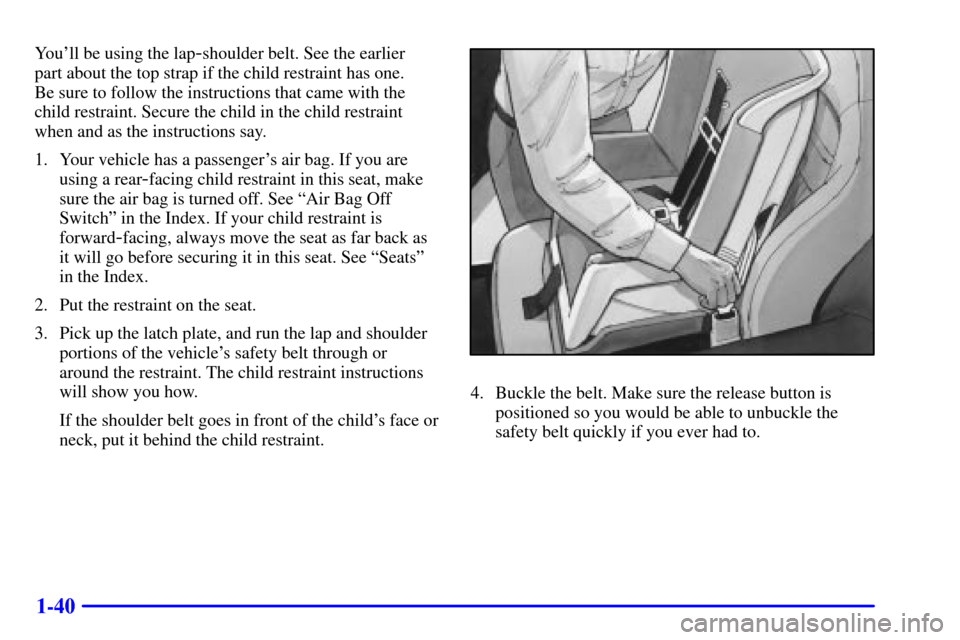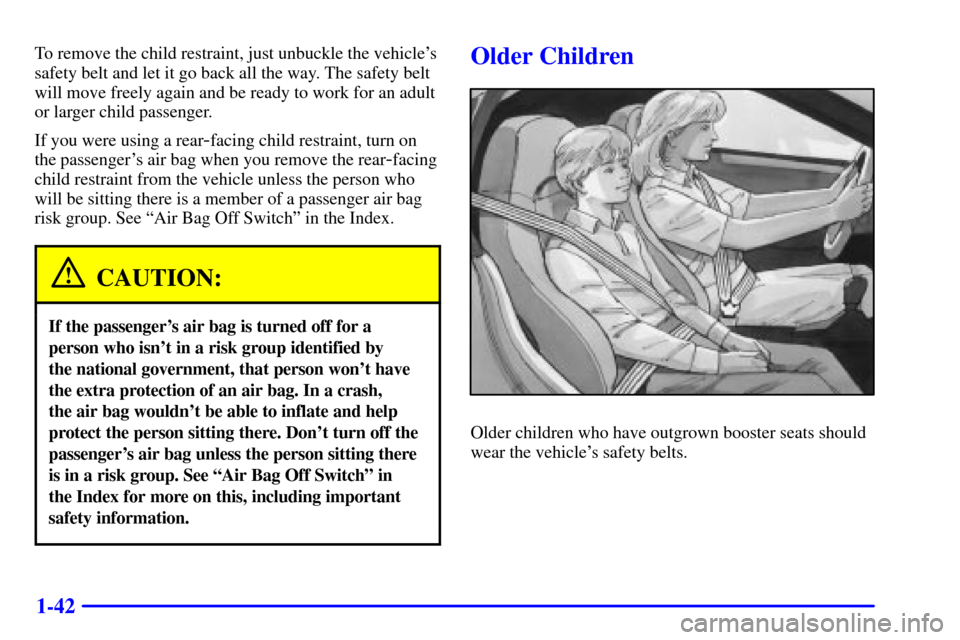Page 14 of 384
1-2
Seats and Seat Controls
This part tells you about the seats -- how to adjust them,
and also about reclining seatbacks and seatback latches.
Manual Seats
CAUTION:
You can lose control of the vehicle if you try to
adjust a manual driver's seat while the vehicle is
moving. The sudden movement could startle and
confuse you, or make you push a pedal when you
don't want to. Adjust the driver's seat only when
the vehicle is not moving.
To move a manual seat, pull up on the lever located in
front of the seat to unlock it. Slide the seat to where
you want it and release the lever. Then try to move the
seat with your body to make sure the seat is locked
into place.
Page 15 of 384
1-3 Power Seats (Option)
If your vehicle has this option, the control for the power
seats will be located on the outboard side of each seat,
near the base.Different parts of the power seat control move different
parts of the seat. To move the seat forward or rearward,
move the control in that direction. Move the control up
to raise the seat and down to lower it. By tilting the back
of the control, it will raise or lower the back of the seat.
Tilting the front of the control will raise or lower the
front of the seat.
Your preferred seat position can be stored and recalled
if you have the memory option. See ªMemoryº in
the Index.
Page 19 of 384

1-7
Safety Belts: They're for Everyone
This part of the manual tells you how to use safety belts
properly. It also tells you some things you should not do
with safety belts.
And it explains the air bag system.
CAUTION:
Don't let anyone ride where he or she can't wear
a safety belt properly. If you are in a crash and
you're not wearing a safety belt, your injuries
can be much worse. You can hit things inside the
vehicle or be ejected from it. You can be seriously
injured or killed. In the same crash, you might
not be if you are buckled up. Always fasten your
safety belt, and check that your passenger's belt
is fastened properly too.
CAUTION:
It is extremely dangerous to ride in a cargo area,
inside or outside of a vehicle. In a collision,
people riding in these areas are more likely to be
seriously injured or killed. Do not allow people
to ride in any area of your vehicle that is not
equipped with seats and safety belts. Be sure
everyone in your vehicle is in a seat and using a
safety belt properly.
Your vehicle has a light
that comes on as a reminder
to buckle up. See ªSafety
Belt Reminder Lightº in
the Index.
Page 25 of 384

1-13
Driver Position
This part describes the driver's restraint system.
Lap-Shoulder Belt
The driver has a lap-shoulder belt. Here's how to
wear it properly.
1. Close and lock the door.
2. Adjust the seat so you can sit up straight.
To see how, see ªSeatsº in the Index.
3. Pick up the latch plate and pull the belt across you.
Don't let it get twisted.
The lap
-shoulder belt may lock if you pull the belt
across you very quickly. If this happens, let the belt
go back slightly to unlock it. Then pull the belt
across you more slowly.
When the lap portion of the belt is pulled out all the
way, it will lock. If it does, let it go back all the way
and start again. See ªLap Belt Cinch Featureº in
the Index.
4. Push the latch plate into the buckle until it clicks.
Pull up on the latch plate to make sure it is secure.
If the belt isn't long enough, see ªSafety Belt
Extenderº at the end of this section.
Make sure the release button on the buckle is
positioned so you would be able to unbuckle the
safety belt quickly if you ever had to.
Page 46 of 384

1-34
A booster seat (F-G) is a child restraint designed to
improve the fit of the vehicle's safety belt system.
Some booster seats have a shoulder belt positioner,
and some high
-back booster seats have a five-point
harness. A booster seat can also help a child to see out
the window.
Q:How do child restraints work?
A:A child restraint system is any device designed for
use in a motor vehicle to restrain, seat, or position
children. A built
-in child restraint system is a
permanent part of the motor vehicle. An add
-on
child restraint system is a portable one, which is
purchased by the vehicle's owner.
For many years, add
-on child restraints have used
the adult belt system in the vehicle. To help reduce
the chance of injury, the child also has to be
secured within the restraint. The vehicle's belt
system secures the add
-on child restraint in the
vehicle, and the add
-on child restraint's harness
system holds the child in place within the restraint.
One system, the three
-point harness, has straps
that come down over each of the infant's shoulders
and buckle together at the crotch. The five
-point
harness system has two shoulder straps, two hip
straps and a crotch strap. A shield may take the
place of hip straps. A T
-shaped shield has shoulder
straps that are attached to a flat pad which rests low
against the child's body. A shelf
- or armrest-type
shield has straps that are attached to a wide,
shelf
-like shield that swings up or to the side.
Page 52 of 384

1-40
You'll be using the lap-shoulder belt. See the earlier
part about the top strap if the child restraint has one.
Be sure to follow the instructions that came with the
child restraint. Secure the child in the child restraint
when and as the instructions say.
1. Your vehicle has a passenger's air bag. If you are
using a rear
-facing child restraint in this seat, make
sure the air bag is turned off. See ªAir Bag Off
Switchº in the Index. If your child restraint is
forward
-facing, always move the seat as far back as
it will go before securing it in this seat. See ªSeatsº
in the Index.
2. Put the restraint on the seat.
3. Pick up the latch plate, and run the lap and shoulder
portions of the vehicle's safety belt through or
around the restraint. The child restraint instructions
will show you how.
If the shoulder belt goes in front of the child's face or
neck, put it behind the child restraint.
4. Buckle the belt. Make sure the release button is
positioned so you would be able to unbuckle the
safety belt quickly if you ever had to.
Page 54 of 384

1-42
To remove the child restraint, just unbuckle the vehicle's
safety belt and let it go back all the way. The safety belt
will move freely again and be ready to work for an adult
or larger child passenger.
If you were using a rear
-facing child restraint, turn on
the passenger's air bag when you remove the rear
-facing
child restraint from the vehicle unless the person who
will be sitting there is a member of a passenger air bag
risk group. See ªAir Bag Off Switchº in the Index.
CAUTION:
If the passenger's air bag is turned off for a
person who isn't in a risk group identified by
the national government, that person won't have
the extra protection of an air bag. In a crash,
the air bag wouldn't be able to inflate and help
protect the person sitting there. Don't turn off the
passenger's air bag unless the person sitting there
is in a risk group. See ªAir Bag Off Switchº in
the Index for more on this, including important
safety information.
Older Children
Older children who have outgrown booster seats should
wear the vehicle's safety belts.
Page 130 of 384
2-72
If the vehicle has lost battery power, you can still
open the storage compartment lid (C) using the
manual release cable.The cable is located underneath the carpeting behind
the driver's and passenger's seats, in the center of the
vehicle. When using the manual release, you must
first open the doors to prevent damage to the seals.
To access the cable, lift and pull back the carpeting.
Then pull the cable to release the storage
compartment lid if needed.
NOTICE:
Be sure that the rear edge (B) of the convertible
top is in the full
-down position before lowering
the top into the storage compartment or damage
to the top may occur.